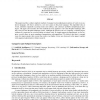Free Online Productivity Tools
i2Speak
i2Symbol
i2OCR
iTex2Img
iWeb2Print
iWeb2Shot
i2Type
iPdf2Split
iPdf2Merge
i2Bopomofo
i2Arabic
i2Style
i2Image
i2PDF
iLatex2Rtf
Sci2ools
CLEF
2007
Springer
2007
Springer
Unsupervised Acquiring of Morphological Paradigms from Tokenized Text
This paper describes a rather simplistic method of unsupervised morphological analysis of words in an unknown language. All what is needed is a raw text corpus in the given language. The algorithm looks at words, identifies repeatedly occurring stems and suffixes, and constructs probable morphological paradigms. The paper also describes how this method has been applied to solve the Morpho Challenge 2007 task, and gives the Morpho Challenge results. Although the present work was originally a student project without any connection or even knowledge of related work, its simple approach outperformed, to our surprise, several others in most morpheme segmentation subcompetitions. We believe that there is enough room for improvements that can put the results even higher. Errors are discussed in the paper; together with suggested adjustments in future research. Categories and Subject Descriptors I.2 [Artificial Intelligence]: I.2.7 Natural Language Processing; I.2.6 Learning; H.3 [Information...
CLEF 2007 | Information Retrieval | Morpho Challenge | Morphological Analysis | Unsupervised Morphological Analysis |
| Added | 07 Jun 2010 |
| Updated | 07 Jun 2010 |
| Type | Conference |
| Year | 2007 |
| Where | CLEF |
| Authors | Daniel Zeman |
Comments (0)

